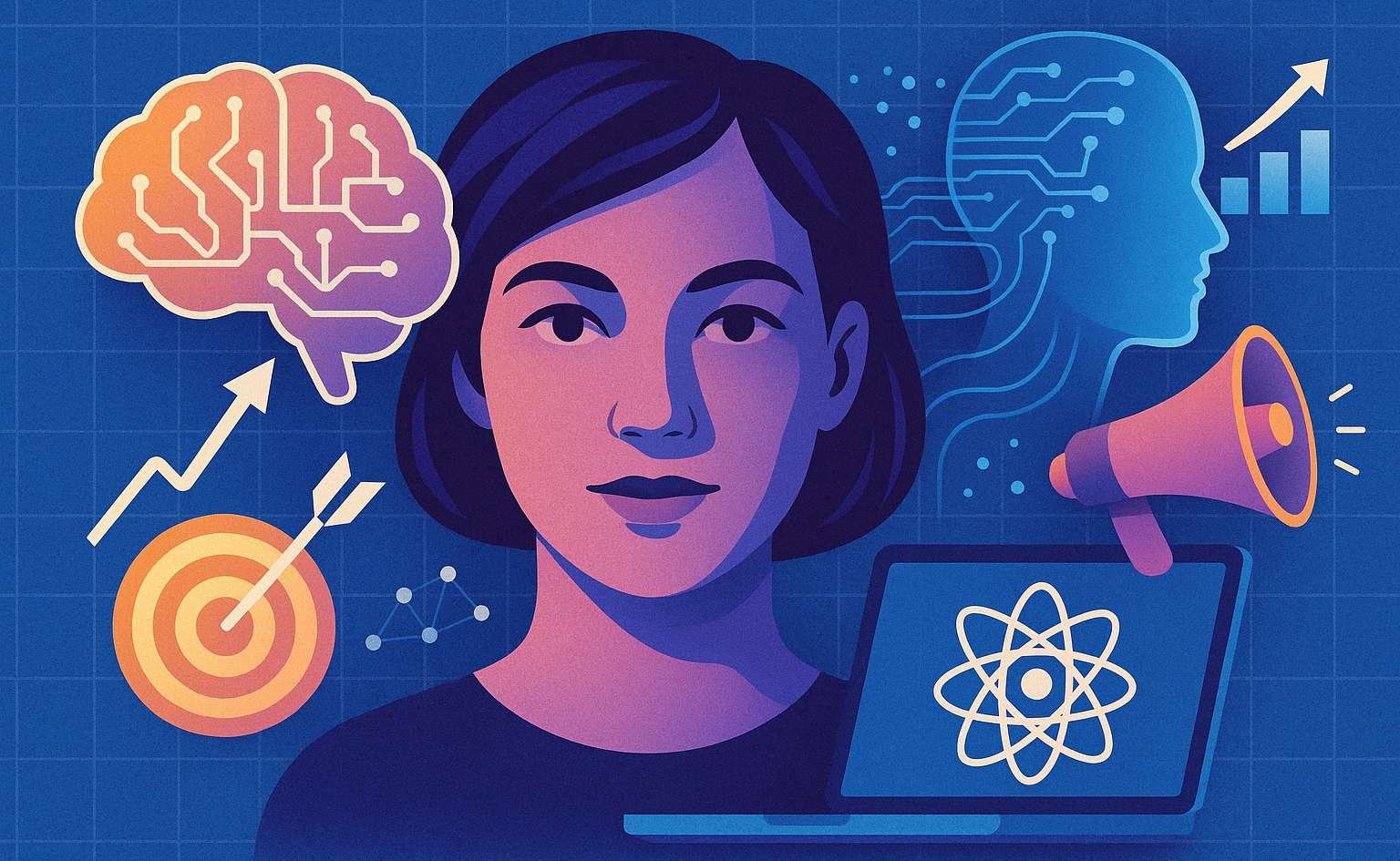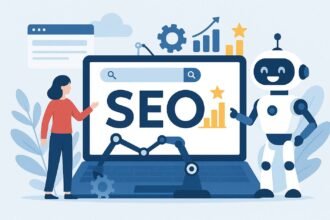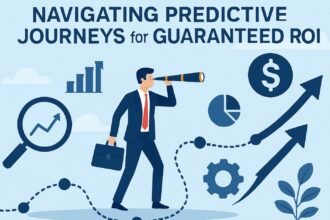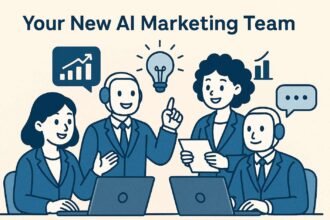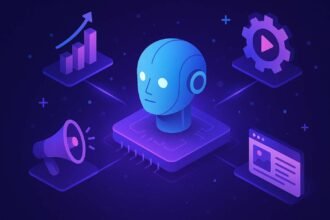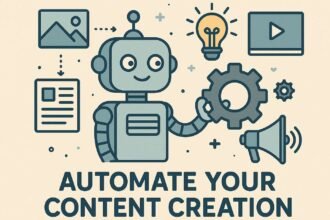Exploring the Role of Generative AI in Marketing
Why is generative AI important for marketing? What best practices support its use? What type of automation will it enable? Why does it matter now?
Generative AI is defined as an artificial intelligence technology that can produce content, including text, images, audio, and synthetic data. It leverages Generative Adversarial Networks, Large Language Models, and Diffusion Models—systems designed to learn from existing content and generate new digital materials. The recent surge in GenAI is largely attributed to novel architectures and the availability of enormous datasets. Additionally, more robust corporate data ecosystems, comprising Customer Data Platforms and Data Lakes, have laid a solid foundation for marketing organizations to engage with generative AI in a meaningful way.
For all but the largest organizations, the starting point is not access to generative AI itself. Open-source and commercial offerings are already accessible to many. More critical is systematically identifying the most promising opportunities in the marketing function and linking those use cases to the corporate data estate and marketing ecosystem. Consumer expectations have evolved: no longer satisfied with blanket marketing approaches, they now demand highly personalized experiences, executed at scale. Generative AI presents an opportunity to deliver on this aspiration. Marketing organizations that begin charting the most compelling use cases now, while critically examining readiness and potential limitations, will emerge as winners in the evolution of marketing.
Understanding GenAI Technologies
Generative AI generally refers to deep-learning models that can generate new output similar to but optimized beyond their training data. Core concepts cover areas of AI foundations, including supervised and unsupervised learning, reinforcement learning, and transformers. Key technologies associated with the recent burst of generative AI interest include language models, diffusion models, and generative adversarial networks.
A large language model takes as input massive amounts of training text, generates word prediction weights, and infers new text based on weights, self-attention, and a prompt. The language modelling process involves neural nets, training, supervised learning, and self-attention. A diffusion model is a type of generative model that creates new data by incrementally introducing noise to training data, learning to reverse this process, and thereby generating new samples by denoising. A generative adversarial network (GAN) employs a generator network to produce synthetic data samples and a discriminator network to evaluate them, with the training process involving a competitive interplay that refines the generator’s outputs to closely mimic real data.
Overview of Generative AI
Generative AI is an emerging technology capable of producing a wide variety of media—images, text, video, audio, synthetic data, and more—based on a body of examples and user input. The most immediately useful applications of generative AI are the rapid, massive-quality improvement it can deliver to content creation, the enormous reduction of manual work it can make for data analytics, and the ability of both those to drive deep, compelling personalization at enormous scale. Explorers in marketing can rapidly identify the best short-term opportunities, the easiest ways to launch, and the ways it can complement existing work. Generative AI is not limited to the marketing domain: open-source tools are launching dozens of new technologies, many of which apply more fully to the analytics and technology teams supporting marketing.
Core concepts of Generative AI include large datasets that teach models, training on thousands of sample documents, user prompts, and the model’s creation of original content in various forms using artificial intelligence subfields such as GPT (Generative Pre-Trained Transformer). The release of ChatGPT in November 2022 marked a major turning point for Generative AI in bringing it into the mass market; since then, content creation has exploded across multiple media, analytics use cases have multiplied rapidly, numerous vertical-specific tools have been developed, and many brands use it for internal content generation or marketing activation.
Key Technologies Driving GenAI
Generative artificial intelligence (GenAI) is making a dramatic impact on the marketing function. Generative AI processes natural language prompts or inputs and uses deep learning algorithms to produce creative outputs such as text, images, video, website designs, marketing emails, and customer-engaging products. The convergence of several trends is enabling GenAI’s rapid disruptive effect on marketing: staggering improvements in computational processing power, massive volumes of data, advanced deep learning algorithms, superior storage, and complexity-reducing software like Langchain.me and HuggingFace. The transformative potential of GenAI in marketing is vast.
OpenAI’s ChatGPT technology serves as a good point of departure for exploring GenAI. The first GPT model was launched in 2018 by OpenAI, a San Francisco-based research company focused on artificial intelligence. It is a large language model (LLM) that can engage in natural conversations across an extensive range of topics. The ultra-large quantities of data powering GPT are processed through newly conceived transformer neural network architectures, enabling understanding and fluent responses to almost any natural language prompt. This scoring-by-relevance process resembles Google’s PageRank algorithm. Each new version has grown significantly in scope, parameters, and capability, culminating in GPT 4 with 10 trillion parameters.
The Impact of GenAI on Consumer Behavior
The marketing world is changing rapidly because of generative AI. Now, consumers expect marketing that is highly personalized and intimately relevant—across many different channels, formats, and voice styles. They want that messaging consistently and 24/7. And when marketers don’t deliver, consumers expect the company to be punished, whether with negative reviews on social media or even a shift in spend or loyalty.
Today, many companies aren’t ready to meet these demand-intensive expectations. But as consumer demand for generative AI grows, those who do will reap the marketing rewards of being authentic, intimate, and personally relevant. In the near term, meeting consumers’ new standards with generative AI is something that marketers can build into an existing campaign workflow with a little creativity and a little effort. It’s not a complete revolution and it’s not a complete reinvention of the way companies build campaigns or communicate with consumers.
Changing Consumer Expectations
Changing consumer expectations continue to drive today’s marketing landscape. Customers expect brands not only to deliver messages that cater to their individual interests, but to do so at remarkable volumes and velocity. Recent advances in generative AI, which enables the creation of diverse types of content, bring powerful new capabilities that can be leveraged to meet—and exceed—those expectations.
Enterprise leaders are now able to tap the marketing-related functionality embedded within products and services offered by every major AI platform, including Google, Microsoft, OpenAI, Stability AI, and Anthropic. Generative AI can be used to assist with content development, from a variety of angles. It mitigates the resource-intensive nature of creative design and copywriting, allowing marketers to focus on determining what content to create rather than on production. It also provides marketing managers and strategists with creative sparks that enable novel campaigns and messaging—as well as fresh ways to synthesize and draw conclusions about what resonates with different audiences—while generating ideas that appeal to their target customer. Moreover, it can quickly scale different types of content, from lifecycle messaging to personalized images for social ads or store displays.
Personalization at Scale
Consumers are also reevaluating their idea of what messages resonate with them. Rather than interest over time, they are now better acquainted with services that tailor their offerings to their perception of who they are at any given moment in time. Finally, consumers are already more familiar with the idea of customization, using tools like chatbots for tech support or relationship managers for banking and tailor-made financial advice.
Furthermore, the smartphone interface—arguably the most sophisticated communication tool that anyone has ever carried in their pockets—has fundamentally changed consumers’ lives and expectations. They expect to be addressed by the brands that provide these services in a manner that is akin to interacting with human beings, so that a service can provide a response that is both context-aware and situation-aware, with a closeness reminiscent of what is achieved by other trusted human relationships. These services also demand immediacy and response that are built with an underlining of human empathy.
Strategic Implementation of GenAI in Marketing
Including generative AI in the marketing mix is similar to when marketing teams started using web analytics tools or paid search: the technology is still new and the full breadth of possibilities remains unexplored. For progressive marketers, unleashing the power of generative AI in marketing means continuously pursuing new solutions that could contribute to different aspects of the business, carefully balancing the promise of the technology with an organization’s goals and tolerance for risk.
There is a strong momentum propelling generative AI change in marketing. Some of the most compelling use cases for marketing have already emerged, are easy to understand, and offer immediate business value. The next wave of ideas for how to incorporate generative AI into marketing will become more nuanced and advanced, requiring deeper integration with marketing strategies and processes, and will make the comparison to paid search and web analytics technologies even clearer.
Identifying Opportunities
Generative AI is making marketers reevaluate their approach to marketing strategy. GenAI’s ability to generate content (text, photos, video, etc.) has created excitement about marketing productivity and creative potential. These new capabilities could take the efficiency of marketing to levels unheard of only a few years ago. Yet many marketers are struggling to see how they might utilize GenAI in the context of their current marketing strategy. To best create a GenAI marketing implementation plan requires viewing GenAI not as a stand-alone tactic but, instead, as a new way to execute marketing strategy—and even an innovative means to develop new strategy.
One of the largest forces driving GenAI’s immediate marketing impact is related to how it can be used for content creation. However, developing new content pieces is only a small portion of the marketing strategy. The greatest challenge when it comes to improving marketing with content is ensuring that enough content exists to respond to the needs of current and prospective customers throughout the entire cycle—from awareness to post-purchase evaluation. Generative AI enables personalized content creation at scale, allowing marketers to adjust their content strategies accordingly. Applying generative AI to the marketing tactic of content creation allows the execution of the personalization strategy that everyone has been striving to implement for over a decade.
Integrating GenAI into Existing Strategies
Having identified an opportunity and a specific use case, marketers can use generative AI (GenAI) to create a marketing activity. GenAI-powered chatbots can engage customers one-on-one, answer questions, and provide personalized experiences, building loyalty. Marketers will find new ways to use AI to assist the customer journey beyond chatbots, such as recommending products or services based on previous purchases, weather, or time of day. “GenAI has the power to solve a problem every marketer faces: keeping up with the never-ending demand for content,” said Christine Cann, partner marketing director at OpenText, a Canadian software company. Simple content — such as ad copy, promotional emails, and social media posts — lends itself well to GenAI. It can also help create video, images, and graphics that tie in with the bigger marketing campaign. Marketers can use tools such as DALL-E 2, ChatGPT, Google Bard, or Jasper.ai to generate ideas or build a complete campaign.
Marketers will want to refine AI-generated content, ideally with their brand tone and style of writing. These tools can be integrated into other applications through software development kits (SDKs) and application programming interfaces (APIs), including Microsoft Word, Microsoft PowerPoint, or a website content management system. Indeed, the integration of GenAI with Microsoft Office is a significant step toward widespread adoption of AI-powered content creation. It streamlines workflows, enhances productivity, and allows users to harness AI capabilities without leaving their familiar Microsoft ecosystem.
GenAI can relieve some of the bottlenecks associated with creative brainstorming and getting ideas started. Marketers often generate four or five concepts internally — then get stuck proving the case for just one. Instead of working on just one idea at a time, marketers can use GenAI-generated concepts to put together a “smörgåsbord” for leadership.
Content Creation and GenAI
The automated creation of engaging marketing content has long been regarded as one of the biggest pain points of marketing. Generative AI technology is positioned to solve this through bots capable of generating relevant, compelling and useful content based on brand specifications. For example, AI-enabled chatbots can engage in preliminary sales conversations with customers, laying the groundwork for human sales agents to close the deal.
Beyond producing content on demand, AI can be a creative partner in marketing campaigns. Human marketers can prompt the AI with the basic premise and tone of a campaign and then quickly cycle through AI-generated concepts, copy, taglines, storyboards, low-content videos and shades of imagery to arrive at a ready-to-execute campaign better, faster and cheaper than when utilizing previous methods. The effectiveness of any campaign depends heavily on insights gleaned through targeted data analytics and predictions, likewise enhanced by generative AI.
Automating Content Generation
Around 80% of corporate marketing budgets go toward creating and placing content. Rising costs, lengthy turnaround times, and minimal effectiveness pose ongoing challenges, including vulnerabilities to global events and economic changes that can cripple content production and lead to missed marketing windows. GenAI addresses these problems by delivering content rapidly and cost-effectively.
More than 70% of marketers already report using GenAI for content production. Emerging use cases are enhancing various content types: blog posts with engaging titles, plagiarism-free text summaries, and AI-generated images; social media content that includes culturally relevant posts, viral hashtags, posts optimized for specific platforms, and tailored language style and tone; video content produced efficiently with AI-powered summarization, editing, contextual content generation, and local language dubbing; and advertising content featuring voice-over synthesis, as well as personalized and localization-optimized advertising copy. As these applications extend, GenAI helps marketers shift from checker to CEO, focusing on defining, steering, and delivering the best possible marketing outcomes.
Enhancing Creativity with AI
Creativity is arguably one of humanity’s most admired features, and its presence is evident across all fields. Regardless of profession, nearly all people must express creativity at certain points. Marketing is no exception: Brands must be unique and compelling to captivate customers in today’s highly competitive and cluttered marketplace.
AI is increasingly transforming many industries and will be equally disruptive for marketing. Interactive and predictive AI tools will become essential for all marketers in the next five years. Brands looking to maintain a competitive edge should already be planning for the future of AI-enhanced marketing. Early experimentation allows stakeholders to gain insights, uncover champions, and implement best practices. As they do so, marketers can also begin assessing AI’s impact on marketing creativity and identifying ways to harness it effectively.
Data Analytics and Insights
Data analytics and insights are prime components of AI’s potential to transform marketing practices. Consumer data, for example, provides rich sources of information for AI-driven analytics. These capabilities enable marketing organizations to pinpoint effective approaches in the marketplace and improve targeting for campaigns. Predictive analytics uses data harvested and stored over time, including data from past customer interactions or internally generated financial and operational data. These types of AI-powered analyses can help constrain options when marketers develop promotional approaches and models.
Assessing and optimizing campaigns before launch is another powerful application. AI technologies can analyze marketing materials—such as communications, materials, and offerings—to flag potential issues and suggest improvements at any stage in the marketing cycle, before a campaign appears. For example, AI systems can analyze historical customer call interactions, quantify emotional sentiment, and then recommend rewording of scripts and emails to maximize their appeal before deployment. Additionally, advances in AI generative technologies may provide further value to analytics activities by automatically generating interesting scenarios for stress-testing models in marketing, finance, and various operational areas.
Leveraging AI for Data Analysis
Use Data to Set Context and Inspire Ideas ◊ Measuring customer behavior may offer the inspiration to develop content that resonates with an audience. GenAI enables marketers to generate headlines, body copy, and even images. For example, an analysis of customer behavior in the previous year may uncover an interesting insight about one or more audiences. Then that insight can be put through the GenAI content factory to generate ideas for new content. Another example is marketing teams seeking ways to engage audiences during upcoming holidays. The GenAI content factory, provided with some context about previous customer engagement around the holidays (and shopping data about natural hair care) may generate ideas for content to inspire and help audiences pursue their individual goals. GenAI can help here and now, but it cannot accurately predict whether the holiday ads will perform better than previous years because it has no actual audience behavior or engagement data.
Use Data to Inform Data-Driven Art ◊ Data-driven artwork can help content cut through the noise inherent in feeds full of ads, friends, brands, and family images. Analysis of customer shopping patterns and social media engagement can help tune data-driven art. Consumer preferences for app or website color schemes, patterns, and movement can guide the development of data-driven art. Visualizing audience segments through data art can help marketers and the business understand the needs and desires of customers, while also providing a foundation for new ways to engage consumers. GenAI can be asked to create data-driven art and can even be provided with both guided preferences and color palettes. But the art, without its connection to data about a particular company’s audience, remains abstract and mostly uninformed.
Predictive Analytics in Marketing
AI models generate recommendations for campaign actions based on data on customer preferences, market trends, or business performance. AI assesses the impact of both past and active campaigns to model their effectiveness. Predictive analytics gives marketers a better understanding of how the target audience will respond to a promotion, including whether or not they will make a purchase. For example, machine learning models detect customers who are at risk of untimely churn from the brand, so they can be targeted with timely retention offers.
These capabilities span multiple areas of the marketing funnel. For instance, AI generates the ideal mix of media channels for a marketing campaign that promotes a brand’s equity or converts visitors toward the desired goal. More scenarios surface the operational value of GenAI for marketing. For example, AI detects whether a brand is positioned well relative to competitive sentiment, and when the timing is best to undertake a new launch or an incremental campaign. It identifies target customers, predicts how prospects will respond to marketing, and prioritizes those with a high probability to buy. These examples support marketing leaders in achieving the efficiency of one-to-one marketing without the operational and labor-intensive challenges.
Ethical Considerations in GenAI Marketing
Generative AI’s rise as a marketing game changer brings challenges besides benefits. Marketers must harness its power in a manner conducive to maintaining brand health and the trust of customers and other stakeholders. Transparency and consumer preferences regarding the use of AI to create content and campaigns—the identification of AI-generated content—and the inherent risks and potential biases present in all uses must be carefully considered and addressed.
Consumer demands are increasingly shaping how businesses use generative AI in their marketing activities. When surveyed about their preferences for disclosing the use of AI in marketing content and campaigns, 48 percent of respondents said that they believed marketers should disclose all marketing content generated with the assistance of AI, and 71 percent said they would be upset if their favorite brands did not disclose that information. The same study showed consumers want companies to do a better job of explaining how they use AI to create content—in particular, about their decision-making process—as 30 percent want more explanations of situations where content is automatically selected for them based on their location, time of day, or shopping behavior.
Transparency and Trust
While brand loyalty remains important, consumers across all sectors have demonstrated a willingness to switch brands and providers, with nearly 80 percent indicating they would do so if presented with a better customer experience. As a result, marketers will need to support a consistent and high-quality customer experience at every interaction. Gartner research projects that by 2025, nearly 60 percent of marketers will reinvent their marketing strategies with a customer-first mindset as a primary driver of marketing planning execution.
As brands and marketers utilize generative AI to interact with customers and communities, building transparency and trust in their identity will be an imperative. Just as important for an internal audience, transparency and trust must also be cultivated among the marketing leadership and broader employee base. Actions marketers can take include openly communicating about their use of generative AI, thoroughly understanding how the algorith.
Addressing Bias in AI
Business leaders face the challenge of combatting algorithm bias, which can skew internal data analyses and result in incorrect judgments or flawed consumer profiles. Bias enters AI applications through training, validation, and testing data, as these models rely on historical data. Training sets that lack representativeness introduce bias directly into the models, potentially producing outputs that discriminate against certain populations or promote stereotypes. Leaders must ensure that data sources reflect their organizations’ diversity and that customers—across generation, region, and culture—feel valued, understood, and treated fairly.
Processing data within AI models also affects disparate impact. Different training and testing methods can create or amplify bias; identical input data may yield disproportionate error rates among distinct groups. Training techniques can exaggerate population differences or pave the way for discriminatory model behavior. To mitigate these risks, model validation must incorporate fairness-aware design, development, and testing to help produce balanced and ethical AI outputs.
Case Studies of Successful GenAI Marketing
The transformative potential of GenAI and its early adoption in marketing are amply demonstrated in the present. As with any emerging technology, early adopters lead the way, paving that path to a broader adoption. Despite the potential, marketing leaders indicate that their organizations are only moderately prepared for GenAI’s impact. Addressing foundational questions—such as identifying viable opportunities, choosing the right partnership model, assembling a capable team, and implementing pilots—all influence ultimate adoption. GenAI’s smart assistants can accelerate and scale content creation, yet in many organizations, the creative function may not possess the expertise or enthusiasm required for success.
Being first has its advantages, with multiple companies already setting a pioneering agenda. The barriers are not exclusively technical in nature. Research reveals that approximately 75% of people are unwilling or unsure how to incorporate GenAI into their shopping routines. Concurrently, these individuals demand greater personalization in brand communications and services. Instances of GenAI misuse underscore the necessity of transparent deployment to avoid eroding customer trust.
Industry Leaders Utilizing GenAI
Industry leaders use generative AI to meet indeed. Starbucks, for example, wants to design and source beverages and foods that delight customers. Amazon, the king of online consumer experience, can’t be left out—it publishes a detailed report on the role of generative AI in product descriptions, advertisements, and overall customer experience.
Leveraging AI models in novel ways unlocks value. Six months of development and testing enabled a Mars Wrigley team to produce 2–3 years’ worth of AI-enabled product concepts and recommendations, reducing time to market by 50%. Others capitalize on GenAI’s ability to generate content on demand. Microsoft, for example, equips its marketing agency with an AI tool that can generate 20–30 pages of content in seconds, with double the normal effectiveness based on their data and analytics.
Lessons Learned from Failures
The rapid adoption of generative AI has delivered notable benefits, but with smeary application and application overcall also comes disappointment. In the marketing space, the technology will be a powerful tool capable of enhancing demand generation campaigns and delighting customers and prospects. However, without proper thought, planning, governance, and consideration of cultural and talent needs, the potential for failure looms large.
To avert such outcomes, building a collection of use cases is highly recommended. Avoid trying to do everything with generative AI at once. Instead, liberate marketing talent by offloading repetitive, boring, uncreative tasks. Determine deployment factors and establish metrics that identify success or failure. Train the AI marketing team, spread best practices across the marketing organization, and always measure the performance of marketing AI assets.
Future Trends in GenAI and Marketing
Generative AI has evolved from a technological breakthrough into a marketing game-changer. What will the next phase look like? Which trends can marketers leverage to advance their own plans, and what new challenges might emerge? Current advances in generative AI are only the beginning. The larger market is taking notice, some sectors more than others. There remain serious challenges in developing and training more capable models. As a consequence, not all organizations or industries will embrace commercial generative AI capabilities that are deployed today. Future trends appear to build not only on the development of better and better architectures but also on the maturation of AI technologies that can support generative AI.
Examining currents beyond technological evolution reveals the broader growth of AI application. As ChatGPT and advances in GPT-4 continue to generate enthusiasm, entrepreneurs are launching ventures aimed at specific market niches or verticals in business-to-business and business-to-consumer markets—along with crowdsourced capabilities, specialized areas of expertise, and more. Either way, these two dimensions contribute to the growth and maturation of artificial intelligence.
The expanding array of generative AI capabilities—and their growing visibility—open up areas of both business opportunity and risk. Increasing numbers of organizations strive to answer questions about viable uses of generative-AI-generated content and services. Soon, every area of human endeavor will either benefit from or be disrupted by generative AI. Future knowledge workers in every domain need to learn how to become power users of the tools. They must integrate the new capabilities into that future workflow, remain conscious of the ongoing challenges and limitations, and grasp the essential nature of “prompt- engineering” interaction. Above all, organizations need to address the essential questions: What problem does generative AI solve? Who will it serve? What decision or action will it inform? Planning and execution are the key.
Emerging Technologies
Generative AI data analytics is an emerging technology that supports marketing data analytics and enhances the insight-generation process. It produces a series of data products, such as digital marketing analytics dashboards and visualizations, natural language marketing intelligence reports, marketing data stories, marketing research for competitors, customers, products, and services, as well as marketing datathons and competitions. These examples highlight the general benefits and capabilities of emerging technologies and tools in the arena of Generative AI for Marketing.
Other Emerging Technologies
“Miscellaneous” emerging technology includes Generative AI tools and applications that cater to specific needs in a particular marketing context. They solve a particular challenge encountered by users, such as selecting an Instagram name, reorganizing Instagram photos into a photo grid, taking compelling selfies, detecting brand logos and brand-related objects in photos, crafting the perfect gift for Milestone occasions, creating subliminal backdrops for office use, removing the background from images, sketching dummy layouts for posters, and designing creative music album covers. These “miscellaneous” Generative AI tools represent a collection of industry-related Generative AI emerging technology launched during the COVID-19 crisis, and together they showcase the solutions provided by Generative AI to a wide range of user challenges.
Predictions for the Next Decade
Understanding GenAI Technologies The world of generative AI is new and emerging, and the terrain is shifting quickly. The next several years will be crucial for the development of generative AI tools, and they will likely define the future of how generative AI-related technologies are adopted in marketing and in other domains. Following one road is a determined journey into the future; sampling many paths reveals future lessons. Several factors affect the direction of generative AI development and adoption in the realm of marketing and other domains. Technical limitations are a major factor. At the other end of the spectrum is market readiness. Generative AI can be as transformative as the introduction of generative printing: both for printed books and printed mass media. Before the latter’s advent in the 15th century, only very rich or powerful people had access to books. After its invention, printed books became available for the masses. Similarly, before the introduction of generative AI, creativity was a process sparingly assigned; for instance, highly artistic commercials had a large budget. Only the rich and influential could see their ideas come to life and envision their impact on culture. However, with generative AI content creation and analysis, an entirely different world can emerge.
Challenges and Limitations of GenAI
Leveraging generative AI in marketing comes with its own unique challenges and limitations. Firstly, technical challenges arise, encompassing concerns about privacy and confidentiality, inevitable bias in algorithms, potential inaccuracies and hallucinated data from AI models, and the risk of creating marketing content that appears robotic and impersonal rather than authentic and effective. Secondly, recent shifts in the AI landscape have introduced additional complications. Acceptable use policies implemented by providers like OpenAI now restrict access to specific datasets or sources. Furthermore, increased demand for ChatGPT has decreased its availability and increased latency. Thirdly, market readiness presents barriers to adoption. Key obstacles include: an immature ecosystem with limited generative AI models, tools, applications, standards, and technology leadership; a lack of stakeholders well-versed in generative AI models and applications; and certain industry-specific regulatory bodies that delay the commercial availability of generative AI products.
As new AI models surface rapidly, organizations must stay updated about potential risks on these dimensions to ensure compliance (adhering to norms and regulations), application/usage suitability (understanding the do’s and don’ts for AI integration with business processes), and optimal data handling (employing correct methods for model training). Marketers who cannot effectively navigate these challenges will struggle to transform their businesses successfully in the GenAI era.
Technical Limitations
Although generative AI is rapidly evolving, it is still in the early stages and carries inherent complexities and business risks. The quality of AI-powered marketing outputs is heavily dependent on the quality and relevance of input data, yet in reality, data often suffers from incompleteness, inaccuracy, and inconsistency. Additionally, many organizations confront technical hurdles due to the absence of effective data management processes and infrastructure—such as issues in data integration and hybrid cloud architecture—that prevent them from harnessing the full potential of generative AI. Moreover, gaps in skills and expertise within marketing teams further hamper the comprehensive adoption of this technology.
Contemporary generative AI models generate outputs based on the available input data and learned patterns without invoking human empathy and evaluation. While some projects that leverage pre-trained Copilot products may utilize these models for internal business processes, creating a competitive edge necessitates fine-tuning the underlying base model with proprietary company data. Leveraging GenAI’s learning capabilities to analyze robust datasets enables marketers to unearth detailed insights—about customers, products, and competitors—thereby forging a competitive advantage.
Market Readiness
Generative AI is revolutionizing the marketing landscape by offering new opportunities for content creation, data analysis, and business transformation. Recognizing its strategic business potential and weaving its capabilities into existing brand values and marketing strategies is a key challenge for marketers today. When contemplating AI’s impact on marketing, several foundational points emerge:
1. Understand the Core Concepts: Before implementing GenAI within a company, the marketing team needs a fundamental grasp of the underlying technologies and trends. 2. Explore GenAI’s Potential: Identify the most promising areas for GenAI application across the marketing mix. 3. Consider the Bigger Picture: Beyond addressable scenarios, consider GenAI’s contribution to customer experience, brand equity, and sales. 4. Act Now: Pursue GenAI initiatives with an experimental mindset. 5. Adopt a Holistic Approach: Combination approaches tend to be more successful. 6. Plan Development: Assess long-term development strategies, such as building intelligent services in-house or partnering with GenAI providers for mature offerings.
Understanding GenAI Technology
The basic principle of Generative AI (GenAI) involves using artificial intelligence to generate new content, including text, images, audio, and video, by leveraging training on extensive datasets that encompass various creations, much like humans do. The key technologies necessary to develop GenAI remain specific artificial neural or brain-like networks. These networks are similar to feedforward deep learning networks—computer programs that process human-created concepts, objects, or text content and categorize it over several hidden layers in different patterns of neurons. The fundamental differences between natural intelligence and artificial intelligence lie in training, learning, and action. Recent advances in Transformer networks—designed to capture intricate semantic relationships within vast textual datasets—have been instrumental in scaling GenAI text generators. This foundational understanding prepares marketers to tackle the next point: how can GenAI contribute to marketing?
Building a GenAI-Ready Marketing Team
The futuristic marketing blueprint for generative AI — henceforth GenAI — budgets one or more effective GenAI-ready marketing teams, and their leadership properly implements sprezzatura with GenAI. Leaders who want the main elements that Intelligence Analysts define as the Best Practice for a GenAI-enabled Org should explore Building a Generative AI-Ready Marketing Team (Asset). The building process starts with an understanding of essential skills, especially for leadership; this foundation reduces the probability of future harm to the organization’s performance. Nevertheless, skills represent only one needed strand. The fishtail braid in Building a Generative AI-Ready Marketing Team (Asset) reflects a comprehensive weaving together of teams, skills, culture, mindset, organization, ways of working, and leadership, thus enabling innovation.
The next pages highlight the marketing manager, who — together with the AI team, data scientists, and business executives — has the often hard-yet-necessary mission of making decisions that can determine an organization’s fortunes. Adaptive routine has always enabled organizations to meet emerging challenges in new competitive contexts, and the succeeding task is to create a culture of innovation where the workforces dare to challenge, reflect, innovate, make decisions, and draw conclusions to enable intelligent organizational behavior.
Skills and Training Required
Implementing generative AI bots in marketing requires both technical and business expertise, along with a deep understanding of the marketing function. The field of AI, especially the subfield of generative AI, is evolving rapidly, necessitating a team of individuals with different skill levels: the Deep AI Science Team, responsible for the data science aspects and managing the AI bots; AI Business Team members, who understand both marketing and AI concepts; and AI Marketing Operations Team members, who have an in-depth understanding of marketing but need only a general awareness of AI technology.
Generative AI technologies are revolutionizing the marketing discipline. The implementation process involves selecting and applying appropriate use cases, considering the technologies underneath the use case, and identifying tasks suitable for automation. Given these layers of complexity, building and training the right AI marketing team is critical. Furthermore, the rapid evolution of AI demands that the team members continually update their knowledge and skills.
Fostering a Culture of Innovation
The ever-increasing move towards autonomous work stems from employees’ desire to deliver on missions that help people, solve problems, and make life better. Harnessing marketing’s full potential requires that the use of GenAI reflect both the marketing mission and aspirations of the employees that make it actionable. Empowering people creates positive in-group externalities. For example, ownership and control can become a driver of intrinsic motivation. People are more likely to strive for and enjoy doing excellent work when they own it. Moreover, autonomy triggers the release of dopamine, which nourishes wellbeing.
The enduring theory that underpins the implementation of GenAI in marketing is the pursuit of a growth mindset. It thrives in an environment where individuals actively respond to uncertainty and failure in curious yet resilient ways. Moreover, where coping with those inevitable setbacks becomes an opportunity for learning. The organization must be capable of nurturing and institutionalizing the routines, practices, and procedures that support the adoption of a growth mindset. Talent teams must also possess the wherewithal for identifying, evaluating, and selecting job candidates that fit the mindset profile.
Measuring Success in GenAI Marketing
Measuring the impact of marketing initiatives—and the return on investment—has never been straightforward, and the advent of generative artificial intelligence brings no hope of simplicity. Marketers find themselves in a paradoxical position. On the one hand, generative AI allows them to craft more relevant, personalized campaigns with more appealing, persuasive content than was previously achievable. On the other hand, the phenomenal rate of execution enabled by generative AI makes it a challenge to develop metrics that provide meaningful assessments of effectiveness.
Some key performance indicators for GenAI marketing include: – Time to market of campaigns. Marketing organizations can assess how quickly they operate relative to competitors and their own previous benchmarks. – Campaign reach. Marketers can evaluate marketing efforts based on the potential audience size or awareness. – Engagement. Metrics such as click rate, response rate, and reply rate reveal the degree of consumer involvement with campaigns. – Consumer profiling metrics. Customer satisfaction scores, churn rates, and intent to purchase give deeper insights into consumer behavior. – Conversion. Analysis of order quantities, order values, and revenue growth helps determine how many consumers took desirable actions.
Key Performance Indicators (KPIs)
Tactics can be defined as the distinctive activities and processes used to execute a strategy. With generative AI, there are a myriad of activities and processes that fall under the umbrella of tactics, including the role of AI in creativity, voice assistants, messaging, robotic process automation, and so on. Kevan Lee, for example, examined the rhetoric about generative AI and tried to identify the most likely uses in marketing, concluding that generative AI’s use in marketing tactics could be grouped into three buckets: brainstorming, cleaning up, and speed.<sup>1</sup>
Strategic implementation starts with identifying the right opportunities within a given marketing organization. Tactics are then layered on top to develop complete use cases that integrate seamlessly with the existing implementation and execution of marketing. Key performance indicators (KPIs) help define the desired outcomes for the use cases. Finally, the workforce is assessed to pinpoint the necessary skills, along with dedicated training programs to effectively build those skills. The more organizations move along the path, the stronger the business case for implementing generative AI becomes, paving the way toward an achievable return on investment (ROI).
ROI Assessment
Return On Investment (ROI) provides the cornerstone for the argument “Why GenAI Now?” Without quantifiable measures, it is difficult to convince teams and stakeholders to invest in time and resources needed to execute on a GenAI strategy and ultimately expand marketing capabilities. Happy to report, it is possible to measure ROI for GenAI in marketing if the right key performance indicators (KPIs) are established and agreed upon before launching any campaign. For ROI to be meaningful and accurate, KPIs should relate directly to the overall business objectives and marketing strategy, (e.g. increasing brand awareness, driving customer engagement, acquiring new customers, etc.) not just AI usage. ROI is especially useful when benchmarking competitors’ progress or to set investment priorities between business groups or marketing teams.
Data is the lifeblood of any AI-powered system. When the dataset powering the AI is of low quality, outcomes produced will be negative, thereby contributing to increased business risk. For example: Google BERT was launched with a release note stating that the model’s data was derived from a mixture of actual searches and synthetic data queries. This trained data is critical to the success of each model, given the significant detail and scope behind it. The challenge from the media perspective—and other business segments—were delivering inaccurate, low-quality predictive data. Thankfully, Google has invested the time and resources to address these shortcomings.
Conclusion
GenAI offers a new era of opportunity and marketing success, but it is not a magic or silver bullet. Unwise GenAI investment and implementation can likely yield failure. However, the thoughtful framework provided aides careful evaluation and a plan for maximizing GenAI investments.
Across marketing and communication disciplines, numerous use cases showcase GenAI’s ability to boost team productivity and deliver greater personalization. While many marketing organizations are actively adopting GenAI technologies, the marketers who will excel in the near term will be those who understand how to evolve their processes to integrate GenAI technologies successfully and strategically. A firm grasp of GenAI fundamentals—whether in natural language processing, natural language generation, recommender systems, chatbots, machine learning, or generative AIs—enables marketing teams to explore—and collaboratively test—methods to improve marketing content development and streamline processes, increasing overall team productivity.
Marketing teams that embrace GenAI tools, technologies, and processes are positioning their organizations to meet the expectations for personalization at scale that consumers increasingly demand. Furthermore, organizations that develop data analytics and insights functions powered by AI and machine learning will be better prepared for programmatic marketing, optimizing real-time, automated campaigns driven by artificial intelligence.


